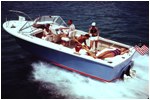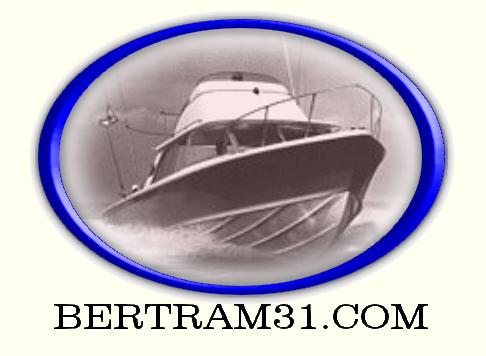THE SALTY TALE OF
A COLORFUL BEGINNING
The 1960 Miami-Nassau powerboat race was a watershed event
- it
marked the birth of Bertram Yacht and the advent of the modern
powerboat with its fiberglass construction, deep-vee design, stern drives
and larger engines. It was also one hell of a bad day to be out there
racing, and it was Bertram's first competition. The seas ran 8 feet, some
say 12, and winds were steady 30 knots, gusting higher.
"What happened on that gusty April day in the Gulf Stream and on
across the clear, rough waters on the Bahama Bank would forever alter
powerboating," reported Soundings magazine (May 1994). "The race
was won by Moppie, a 30-foot wooden prototype designed by
C. Raymond Hunt for Miami yacht broker Richard Bertram and named
after Bertram's wife. With a constant 24-degree deadrise running fore
and aft, Moppie ushered in the era of the modern deep-vee hull. The
Ray Hunt design turned out to have a terrific ability in rough water,
and it really set boatbuilding on its ear."
Moppie set a course record of eight hours flat when she crossed the
finish line two hours ahead of the second-place boat. That she
finished at all was remarkable. Conditions were so poor that the
aluminum chairs used by Bertram and crew crumpled shortly after
the starting signal, and the men found themselves standing on the
deck for most of the race.
The only other boat to cross the finish line that day was the one other
vee-hull. Essentially, a 24-foot version of Moppie, it was driven by MIT
engineer Jim Wynne and boating writer Bill McKeown. No one else
came in. The rest of the fleet returned to port or finished the next day.
"It changed the face of yachting forever", said Jim Martenhoff, a
pioneer in rough-and tumble South Florida ocean racing and a former
boating editor for the Miami Herald. "No other single event has had as
great an impact on powerboating as the 1960 Miami-Nassau race."
(Soundings, May 1994)
 Bertram first
encountered Hunt's
Bertram first
encountered Hunt's
experimental powerboats during America's
Cup trials in 1958. He noticed a 23-foot,
fiberglass prototype, designed to be a tender,
slicing through the chop of Block Island
Sound. Bill Dyer (who came in second in the
legendary 1960 race) had laid up the
fiberglass on the swift little tender. After
running it himself. Bertram wrote, "Knifing through those six-foot seas
at 30 knots, this little 23-footer stopped every sailor...in his tracks. No
one had ever seen powerboat performance to approach it." Bertram was
impressed enough to commission a wooden 30-footer from Hunt. The
boat was finished in early 1960 and christened with a bottle of
domestic champagne.
One legend says Bertram planned to race Moppie from the beginning.
Another version says he wanted Moppie as a utility boat, but powerboat
racing partner Sam Griffith, awed by its prowess in rough water, talked
Bertram into competition. "Griffith drove and throttled Moppie in the 1960
race. The third member of the team was offshore yachtsman and writer
Carleton Mitchell, who served as navigator and filed a story on the race
for Sports Illustrated." (Soundings, May 1994).
 After the
1960 race, Bertram
After the
1960 race, Bertram
turned Moppie into a plug, a mold
was cast and the first fiberglass 31
was created. The following year
Bertram again won the
Miami-Nassau race, this time in
Glass Moppie, the fiberglass version
of the prototype.
Some observers say that originally,
Richard Bertram had no intention of
building a company, but that the
publicity surrounding the two races
sparked such interest in the new hull form that he just couldn't ignore the
opportunity. As Bertram told Martenhoff, "Jim, there were so damn many
yachtsmen waving checkbooks at me that I had to go into business."
Production of the now-legendary 31' Bertram started in a rented
warehouse in Hialeah. The same hull mold produced a number of race
boats and Bertram dominated the ocean racing circuit, while gaining
valuable knowledge of structural integrity that was applied in construction
of production Bertrams.
Before the molds were finally retired, the company built 1,860 Bertram
31's over 16 years, including 23 special-edition models. The 31 came in
four configurations. The original open Sportfisherman had a lower
steering station and no aft bulkhead. The Fly Bridge Cruiser added a rear
bulkhead. Bertram also offered the 31 as a hardtop and as an express
cruiser, the Bahia Mar.
"The 31 has become a benchmark both in terms of seakeeping ability
and rugged fiberglass construction. It has had a reputation from the start
as a boat that will take you out and bring you back."
(Soundings, May 1994).
"They went to rogues and royalty, grizzled marlin captains and
fair-weather sailors. Many of them are still tearing across the
whitecaps..." for customs and border patrol work, search and rescue
missions, and, of course, to ferry anglers to offshore fishing grounds.
The Bertram 31 launched Bertram Yacht, Inc. when it was introduced
at the 1961 New York National Boat Show, essentially as a day boat
for Florida sport fishermen. More than three decades later, it is a
collectible classic, sought-after, even coveted. According to Soundings,
aficionados refer to it as "Bertram Art." The Bertram 31 has aged well,
a tribute to its impeccable blood lines and robust construction."
Credit: Bertram Yacht 

 Bertram first
encountered Hunt's
Bertram first
encountered Hunt's After the
1960 race, Bertram
After the
1960 race, Bertram